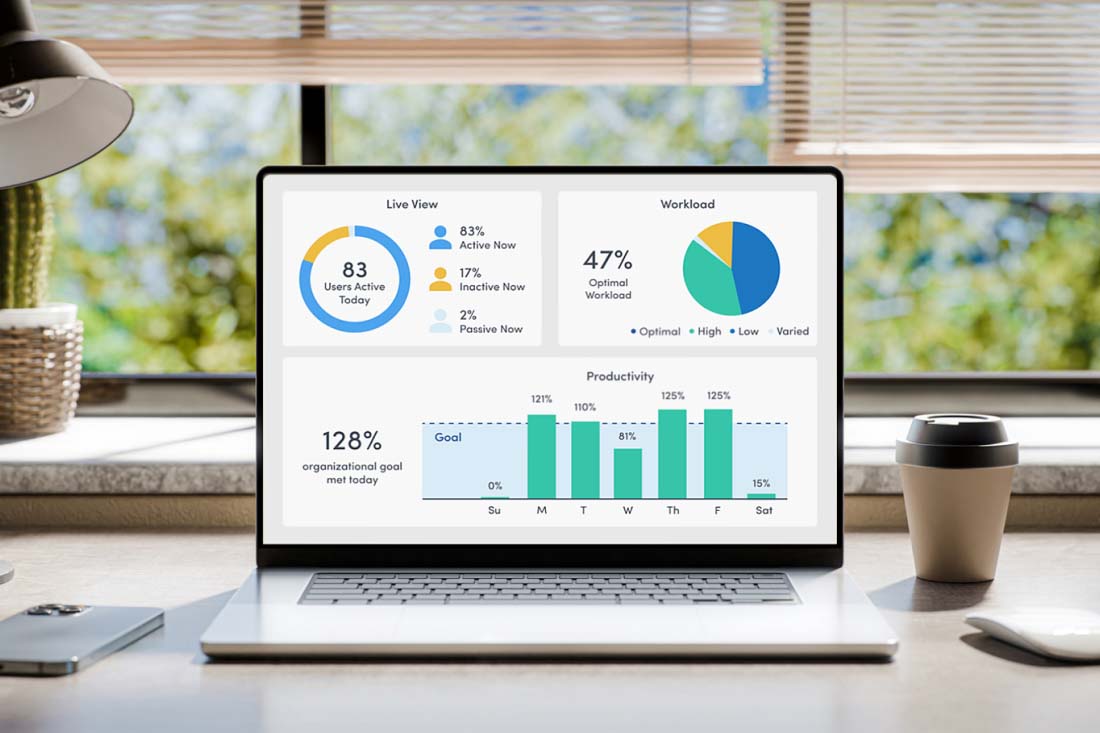Workforce analysis has traditionally been used to help organizations lower turnover rates, optimize onboarding and talent management, address skill gaps, and so much more. Today’s managers are applying the workforce analysis process more broadly to optimize performance by leveraging the insights it provides across operations and in technology and process decisions. Workforce analysis is essential to effectively leverage data to gain a better understanding of your current workforce and make targeted interventions to help employees work wiser.
Read on to learn about workforce analysis and how ActivTrak’s workforce analytics solution takes it to the next level.
Click to navigate to the information you need:
- What is Workforce Analysis?
- Benefits of Workforce Analysis
- How to Conduct a Workforce Analysis
- Workforce Analysis Examples
What is Workforce Analysis?
Workforce analysis is a process of collecting and analyzing business data to understand the current state of the workforce and plan for future needs. It utilizes workforce analytics from employees, processes, and technology to spot trends and provide actionable insights that can influence decisions on hiring, retention, and talent management.
The purpose of a workforce analysis is to ensure your business has the right employees, in the right roles, with the necessary skills at the time you need them. It helps managers across every department understand their workforce and what’s needed to achieve success, whether that’s hiring more people or focusing on training and retention for your current employees.
Benefits of Workforce Analysis
Workforce analysis is integral to human capital management (HCM) — everything having to do with human resources, employee satisfaction, employee retention rates and general talent management. But it’s also more than that. Workforce analysis can help business leaders and managers identify the most pressing onboarding needs, assess the most critical competencies needed to fill or prevent staffing skill gaps, determine areas where bottlenecks or burnout might be causing issues, and develop a future workforce prepared to tackle upcoming fluctuations in the industry.
In addition to these benefits, workforce analysis can also help HR teams and managers alike:
- Optimize scheduling
- Track employee engagement and employee performance
- Design more efficient workflows, leveraging automation where beneficial
- Adjust processes
- Reallocate resources
- Improve employee retention rates
- Manage operating costs
- Use benchmarks to compare performance to other similar companies
How to Conduct a Workforce Analysis
Conducting a workforce analysis is pretty straightforward when you have the right tools and metrics, but it’s important to remember that workforce analysis is a continuous process. While there are steps to follow to get started, you’ll likely find yourself revisiting different stages at multiple points during your analysis, depending on what you’re looking to address. Here’s where to begin your workforce analysis:
1. Identify a purpose
Determine why you’re generating a workforce analysis report. It could be because you have a challenge you want to address, such as a process issue or a question about technology needs, or it may be to help predict a future outcome. Knowing the end goal is essential so you can focus on the correct metrics and insights.
Here are some examples of the different purposes for generating a workforce analysis report:
- Address Employee Turnover: Identify patterns in attrition rates to reduce turnover and improve retention.
- Improve Productivity: Uncover inefficiencies in workload distribution or time management.
- Plan for Growth: Forecast staffing needs and skill gaps for upcoming expansions.
- Evaluate Technology Needs: Analyze the impact of outdated tools and assess the need for new technology.
2. Collect and organize employee data
Make sure you’re basing your workforce analysis report on high-quality data gathered ethically and transparently. A workforce productivity monitoring solution can do the heavy-lifting for you — collecting and organizing data so you can gain the insights you need quickly. In fact, a workforce monitoring solution takes care of multiple steps in the larger workforce analysis process and keeps continuous monitoring and analysis in place for you.
No matter whether you use a tool or collect data manually, remember: Your employees should know you’re collecting workforce analytics data, and you should openly share the purpose is to help create a better workplace for everyone. Transparency neutralizes any potential trust issues and increases employee buy-in.
3. Analyze results to find trends and predict outcomes
Centralize the data and search for insights that support your ultimate goal. If possible, create visual representations of the data, including graphs, charts and diagrams that reflect those insights. With a quality workplace analytics solution, those visualizations are built-in, making it much easier to find the trends that help predict future outcomes.
4. Discuss findings with stakeholders
You may want to present your findings in a report or a dashboard, but no matter your approach, ensure the data and related insights are clear and easy to understand. Visual elements help you achieve that.
5. Provide recommendations with clear KPIs
Using the insights gained during the analysis stage, offer stakeholders recommendations for how to address the challenges or make future improvements. For example, if your gap analysis found that an overworked team is on the verge of burnout, recommend hiring a freelancer or rebalancing workloads. Or, if your analysis forecasts there will likely be a skills shortage a year from now, suggest the human resources team start the hiring process now to prevent future staffing issues.
Your recommendations should contain clear key performance indicators (KPIs) to use to determine if you’re meeting goals. To make the most of those KPIs, your organization will want to engage in continuous workforce data collection and analysis to see if the changes you implement have a positive impact. Make sure to leave ample time to make further adjustments if necessary.
6. Reassess and make continuous improvements
We’ve said it before, but it bears repeating — workforce analysis is not a one-and-done process. Your organization isn’t static, and there’s no guarantee that the initiatives that worked last quarter are the right fit months later. Use workforce analysis data to set benchmarks and make changes, examine their impact, make further adjustments and improvements, and then return to the data again to reassess.
Workforce Analysis Examples
Here are two sample scenarios of how workforce analysis can positively impact a company.
Enhancing Workforce Planning
It’s the end of the year, and a manager has received their department’s budget for the upcoming quarter. The past year uncovered some staffing issues and the manager knows the department could use some new hires, but they’re not exactly sure how many or which teams need the extra help. Workforce analysis can help them flag over-utilized employees to plan for future hires and ensure teams get the support they need.
Optimizing Processes and Resource Allocation
Imagine a team of ten writers and three editors. A 13-person team may seem like more than enough to push articles through on time, but they’re barely meeting deadlines. Workforce analysis can help managers uncover process bottlenecks by highlighting process and technology inefficiencies or identifying individuals who might be in a position to take on more projects to help balance workloads.
When the team’s manager performs a workforce analysis, they discover there’s a bottleneck at the editing stage. The writers generate a lot of content, but three editors can’t keep up with demand. The workforce analysis report also shows that the editors are overworked and at risk of burnout, which could cause issues down the line if one of the editors should leave the company.
Now the manager knows they need to reallocate resources, potentially giving one or more of the writers editing responsibilities to help lighten the workload for editors and eliminate the process bottleneck. After implementing the changes, they will continue performing workforce analysis periodically to see if the change had the intended impact and make further adjustments as needed.
Conduct a Workforce Analysis with ActivTrak
Workforce analysis can be incredibly beneficial across a variety of areas within a company, but you need a tool that collects key metrics and uses intelligent algorithms to analyze data and deliver insights that will support better performance management and workforce planning to get the most out of this process.
ActivTrak has everything you need to get started with workforce analysis and transform your workforce for the better. ActivTrak’s Workforce Analytics platform collects current and historical data, generates workforce management insights based on the latest data, and offers tailored recommendations on how you can help employees work wiser. Also, our workforce optimization solution allows you to create visual representations of the data in your workforce analysis reports for easy sharing among stakeholders. Request a demo of ActivTrak today to learn more.





